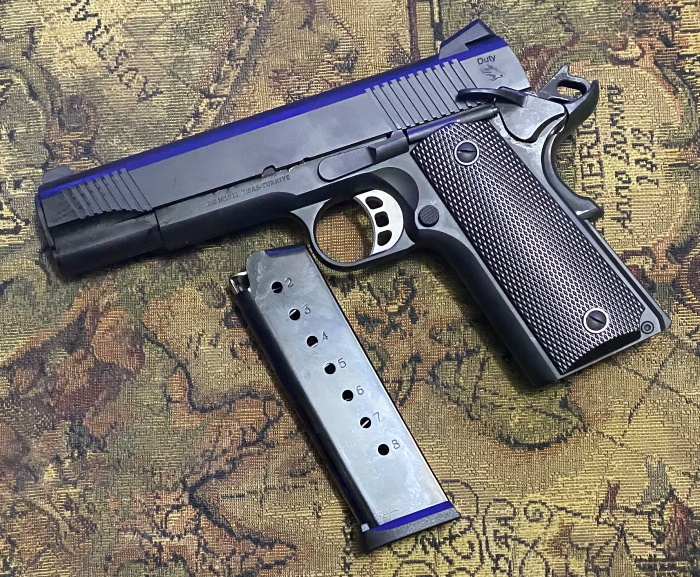I’ve alluded to a 1911 project in 9mm but details have been a little vague. This post will help that to a degree but there will still be questions at the end. Please bear with me. I’ve got a plan but what I plan and what actually takes place ain’t never but similar, to quote the immortal Jane Cobb. The plan is evolving.

The plan is to build a rapid-fire pistol for competition, which makes 9mm a no-brainer. In terms of shooting quickly and accurately 9mm is ‘Cheat Mode’ in the 1911 frame. More bullets and less recoil also serve the mission so 9mm it is.
After careful negotiations with The Mistress of Finance and taking into account the generous contributions of my Patreon supporters we established a modest budget for the project. In a world where money was no object I’d have started with a custom Caspian slide and a Les Baer frame, but I don’t live in that world. Top-of-the-line components were for the most part not going to be a thing, and I needed to save what money I could for where they did need to be a thing if that should occur.
After pricing frames and internal components I determined that I could meet my goals for significantly less money by starting with a donor gun rather than buying the parts individually. This would also save a lit of time assembling the gun as I would be starting with everything in place and working. After careful research and consulting with people who should know I bought the TISAS .45 I reviewed in a previous post. Caliber wasn’t particularly relevant as I would be replacing the slide regardless. I had my jumping-off point.
Because, uh, Reasons
Since I first got to fire one in the 1980’s I have known that the Detonics Combat Master was maybe the best stock .45 ever for double-taps. The light reciprocating mass of the short slide, fast lock-time, and other features combine to bring the gun back on target very quickly. In 9mm it just gets better. It has it’s downsides like the very short sight radius, heavy weight and truncated grip, but overall they are great self-defense guns.
Many of these are easily addressed; the idea of the short slide combined with a full-sized grip has been done, as Kimber does in their Pro-Carry series.
The perception of softer recoil and fast recovery between shots make this Linda’s favorite 1911 configuration in .45 ACP. This concept is the starting point for my 9mm project, but it’s just the starting point. It’s going to get much more complicated than that.
Getting Started
With the TISAS in-hand I could get started while still waiting for other components to arrive. I began with optimizing the grip-frame.
The standard flat mainspring housing provided with the gun needed modifying both for shape and better traction. I blended the edges first so that the back surface of the safety provided a single smooth arc from one edge to the other and I rounded the bottom edge as well. I then cut 20 line-per-inch (LPI) checkering on the mainspring housing. This creates a comfortable but grippy surface. I also blended the edges of the ‘speed-bump’ on the grip safety to present a similar smooth arc.
I also hand-cut 20 LPI checkering on the front of the grip-frame. I increased and blended in the undercut on the trigger-guard as well. There’s still finishing work needed on the checkering, but it already provides a fantastic and not overly abrasive grip. That was all the work needed on the frame for the moment.
The 9mm Slide.
Originally I planned to get a fully custom slide from Caspian, but that would have entailed significant expense and an unacceptably long time-frame for delivery. On Ebay I found a 3.5 RIA 9mm barrel for $69 and a matching slide for $119. That’ll do. I removed the .45 ejector from the frame and fitted the barrel and slide to the frame. The barrel needed extensive fitting to the frame as it was a ramped full-support barrel but the TISAS has a conventional frame. Machining the frame to accept the barrel would be an incredible PITA with my tools so I adapted the barrel instead, converting it to a conventional-profile barrel. The EGW recoil assembly and guide-rod (About $73 incl. tax and shipping) also required a bit of fitting, but that was almost inconsequential by comparison.
As currently set up the gun will easily hand-cycle rounds from the Sig Sauer 9mm magazines I selected to feed the gun, but I am likely to need to do some feed-ramp work if for no other reason than my brain says I should.
In a couple days the 9mm ejector will arrive, and after installing that I’ll test-fire the gun before going to the next steps. Those next steps are where things are going to start to get crazy. Suffice it to say the GI sights on this slide will be replaced and some other issues will be addressed as well.
OK, the obvious question is, ‘Why not a 2011?’ The answer is simple; they’re expensive. Expensive enough to break the budget, in fact. So 1011 it is.
Stay tuned for the next exciting episode ‘Gunsmith Wannabe’s Gone Wild!’
Stay safe and take care
Michael Tinker Pearce, 22 November 2021.
If you like what you see here please consider clicking the link above and supporting me on Patreon.